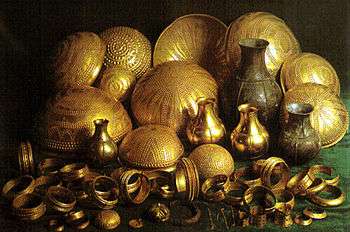Treasure of Villena

The Treasure of Villena (Spanish: Tesoro de Villena) is one of the greatest hoard finds of gold of the European Bronze Age. It comprises 59 objects made of gold, silver, iron and amber with a total weight of almost 10 kilos, 9 of them of 23.5 karat gold. This makes it the most important find of prehistoric gold in the Iberian Peninsula and second in Europe, just behind that from the Royal Graves in Mycenae, Greece.[1]
The gold pieces include eleven bowls, three bottles and 28 bracelets.
The iron pieces are the oldest found in the Iberian Peninsula and correspond to a stage in which iron was considered to be a precious metal, and so was hoarded. The archaeologists estimate the date of this trove at c. 1000 BC.
The hoard was found in December 1963 by archaeologist José María Soler 5 km from Villena, and since then has been the main attraction of Villena's Archaeological Museum. Its discovery was published in most of the Spanish media and also some abroad, mainly in France, Germany and the United States of America. It has been exhibited in Madrid, Alicante, Tokyo and Kyoto, and now there are two sets of copies of the whole treasure to be shown in exhibitions while the originals are permanently conserved in an armoured showcase at Villena's Archaeological Museum.
The same type of metalwork is also found in the big Eberswalde Hoard that was discovered in Brandenburg, Germany, in 1913.
See also
References
- SOLER GARCÍA, José María (1967). El tesoro de Villena: memoria redactada por José María Soler [The treasure of Villena: a memory by José María Soler] (in Spanish). Alicante: Editado por Biblioteca Virtual Miguel de Cervantes, 2005. [Madrid]: Otra ed.: [Madrid], Ministerio de Educación Nacional, Servicio Nacional de Excavaciones Arqueológicas, D.L. 196, 75p,[42]p. de lám : il ; 25 cm (Excavaciones arqueológicas en España ; 36).
- M.I. Ayuntamiento de Villena, Villena ¡Un tesoro!, Touristic Guide to Villena. referring to the Treasure of Villena. (in English)
- ↑ "RESOLUCIÓN de 7 de enero de 2003, de la Dirección General de Patrimonio Artístico de la Consejería de Cultura y Educación, por la que se incoa expediente de declaración de bien de interés cultural a favor de la colección arqueológica del Tesoro de Villena." [January 7, 2003, RESOLUTION of the General Direction on Artistic Heritage of the Culture and Education Council, which opens a file on the declaration as Good of Cultural Interest (BIC) the archaeologic collection known as Treasure of Villena] (pdf). [Spanish] State Official Bulletin (BOE) (in Spanish). Madrid: Spanish Government (49): 7798–7802. 26 February 2003. Retrieved December 6, 2009.
Desde el punto de vista histórico, artístico y arqueológico, el Tesoro de Villena constituye un «unicum», un depósito no normalizado, por su peso y contenido (A. Perea). De hecho, se trata del segundo tesoro de vajilla áurea más importante de Europa, tras el de las Tumbas Reales de Micenas en Grecia (A. Mederos). From a historic, artistic and archaeological point of view, the Treasure of Villena constitutes a "unicum", a non-normalised deposit, according to its weight and content (A. Perea). In fact, it is the second most important golden tableware finding in Europe, after that of the Royal Graves in Mycenae in Greece (A. Mederos)
line feed character in|quote=at position 141 (help);|first1=missing|last1=in Authors list (help)
External links
| Wikimedia Commons has media related to Treasure of Villena. |
- Museo Arqueológico José María Soler, where it is exhibited.
.svg.png)